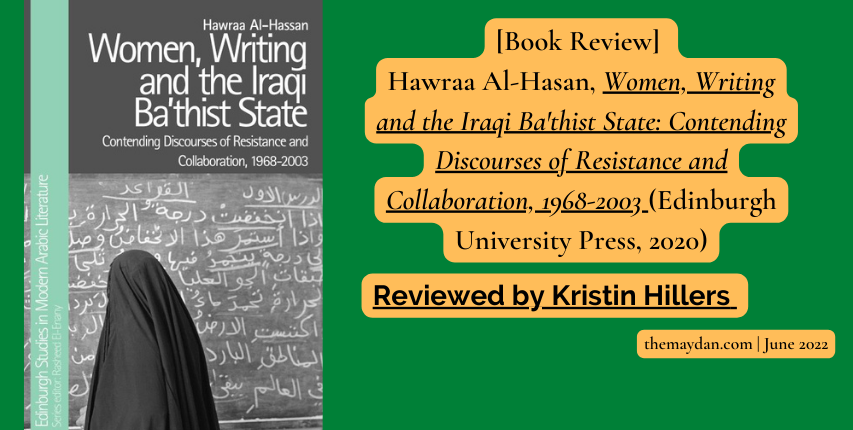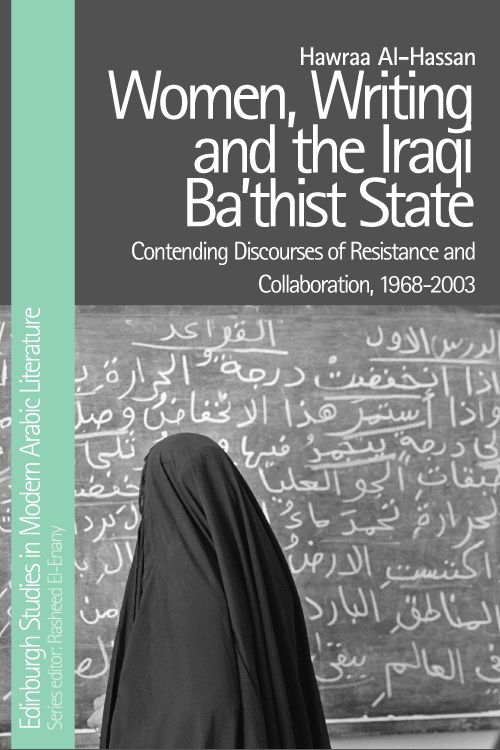
Hawraa Al-Hassan, Women, Writing and the Iraqi Ba‘thist State: Contending Discourses of Resistance and Collaboration, 1968-2003.Edinburgh University Press, 2020. 264 pages. $29.95, paperback.
Hawraa Al-Hassan’s Women, Writing and the Iraqi Ba‘thist State: Contending Discourses of Resistance and Collaboration, 1968-2003 illustrates how literary production cannot and does not exist in a vacuum. The core premise upon which Al-Hassan builds is that genre of the novel was used both for hegemonic and counter-hegemonic purposes and occupied a distinctly political space within Iraqi discourses of the studied period. This broad classification of hegemonic and counter hegemonic provides the broad structure of the study, which is then divided into four chapters.
“The core premise upon which Al-Hassan builds is that genre of the novel was used both for hegemonic and counter-hegemonic purposes and occupied a distinctly political space within Iraqi discourses of the studied period.”
Chapter 1 details the representation of women in Iraqi cultural production. Chapter 2 analyzes Saddam’s Hussein’s novels as hegemonic representations of Iraqi women. Chapter 3 examines the religious writings of women, in what Al-Hassan describes as the appropriation of the novel as a genre by religious authors. Finally, chapter four explores women’s life writings and concludes the study by examining “the practical applications of Genette’s concept of transtextuality” (18). The place of literary production in the creation of hegemonic and counter hegemonic discourses, especially within Ba’thist Iraq, is an understudied phenomenon and Al-Hassan’s Women, Writing, and the Iraqi Ba’thist State furthers the discourse on this topic while demonstrating that there are opportunities for additional research. Al-Hassan states “the focus of the book is, to use the words of Abir Hamdan, on the ‘ongoing struggle for symbolic power in the Arab world’” (1). She explores this struggle by examining two narratives, that of the manipulation of idea of femininity by the Ba’thist regime as well as “the modern Iraqi novel and (its) relationship with state patronage” (3). This analysis comprises the first two chapters of her work as well as her analysis of hegemonic writings as a whole. She argues that “in its efforts to synthetically ‘create’ a new national identity, the Ba’ath also forcefully ‘created’ a modern propagandistic Iraqi novel at the peak of nationalist mobilisation and economic prosperity” (4). This development triggered “the creation of a counter discourse or narrative which challenges the homogeneity of the utopian narrative projected by the state” (4). One may think that on its face this argument is a simplistic one, setting the Ba’athist regime as the authoritarian, hegemonic state and women’s writing as the counter-hegemonic discourse that highlights the brutality of the regime. Al-Hassan herself notes that this is the very argument the United States made to justify its invasion of Iraq in 2003. However, the author makes it clear that this interpretation is an oversimplification, one that is “essentially political” (7). Al-Hassan addresses this oversimplification by departing from “a simplistic structuralist Marxist interpretation of complete reliance on the ideological state apparatus on the material base” (7).
Hers is not a study of material production, concerned with publishing and readership, but rather the formations of gender expressed within the texts. She borrows concepts from Foucault, Jameson and Spivak to frame her argument, and in doing so methodologically complicates the analysis of literary production. Her work follows the model of Sabry Hafez’s The Genesis of Arabic Narrative Discourses and as such is a sociological examination of literature. Rather than dismissing popular or “non-artistic” works, as traditional examinations of literary production tend to do, Al-Hassan examines not only the religious and ‘life’ writings of women, but also the propagandistic novels of Saddam Hussein, which she calls “the literary parallel to the Ba’thist political discourse” (32).

It is here that the title of Al-Hassan’s book becomes misleading. While Al-Hassan devotes the second part, chapters three and four, of the book to women’s writing, the book is as much about the articulation of masculinity found within Saddam Hussein’s novels as it is about the articulation of femininity both by the hegemonic and counter-hegemonic discourse. It would be more accurate to instead say that Al-Hassan is examining gender and the political and cultural space it occupies in the novels of this period. In chapter 2, she notes that within Hussein’s novels, there is a “conflation of manliness with extreme violence” (48). She further explains that there was a “gradual male encroachment into the female sphere in order to regulate and control female activities,” thus establishing the hegemonic discourse (57-8). This is due in part to the Iran-Iraq War, which coincided with the adoption of conservative social practices and attitudes. Women become excluded from the hegemonic narrative, while more emphasis was placed upon the hyper-masculine, pro-war texts created by men, namely Hussein’s series of novels. Indeed, Al-Hassan exclusively examines Hussein’s novels. She notes that the novels are forms of propaganda and that they are often ignored by academic disciplines because they are both literary and propaganda. Within these novels, women become an ideal, a symbol of utopian Iraq and Iraqi nationalism. Al-Hassan notes that there is an inherent dilemma in depicting what she calls the feminine ideal, that women as a symbol contradicts any realistic depiction of women or, for that matter, any believable character. This observation comes as mostly an aside and again demonstrates the necessity of more research into Iraqi literary production.
“It deserves to be mentioned, yet does not appear in Al-Hassan’s argument, that these works—literary or propaganda, both or neither—are works created by men and articulate a version of masculinity that did not accurately reflect the reality of the identities of male Iraqis. Al-Hassan’s work, at least in the first part, is as much about men as it is about women.“
It deserves to be mentioned, yet does not appear in Al-Hassan’s argument, that these works—literary or propaganda, both or neither—are works created by men and articulate a version of masculinity that did not accurately reflect the reality of the identities of male Iraqis. Al-Hassan’s work, at least in the first part, is as much about men as it is about women. This is an interesting argument to make, especially considering that the field of Middle Eastern gender studies is saturated with discourse about the status of women in Middle Eastern societies. By taking on gender as a construct and how it is created and manipulated within the Ba’athist state, Al-Hassan does exactly what she seeks out to do—complicate the narrative about women’s writings in Iraq during this period. She merely does it in a way that seems an unintended consequence. One also wonders if the writings that Al-Hassan positions as counter-hegemonic fulfill that definition, or if they have the capacity to do so. Given that they are written and published within the Ba’thist state rather than outside of it, they are a product of those hegemonic conditions. This argument is not fully considered by Al-Hassan and demonstrates the necessity for further research.
“Women, Writing and the Iraqi Ba’athist State does what it seeks out to do—it complicates the discourse surrounding women’s writing in Iraq. It demonstrates the necessity for more research into this field of study, as there are many lines of inquiry that deserve further analysis, such as the utopian element of Iraqi hegemonic writings, the formation of gender identities and whether the writings Al-Hassan identifies can be classified as counter-hegemonic.”
In the second part of Women, Writing, and the Iraqi Ba’athist State, the focus becomes exclusively on women and women’s religious and secular writings. For the chapter on religious writings, Al-Hassan terms the use of novels for religious purposes as appropriation, a pragmatic decision by Islamic writers to dissuade young female readers from secular novels (107-8). With the use of that term, Al-Hassan is making the argument that novels are inherently secular objects. Again, it comes across as almost an unintended argument, one that is not fully fleshed out. It is an interesting argument to make and one that deserves further analysis. The religious novels Al-Hassan examines are written by Shia women, and she notes that Shia Islamicisation of gender roles became tools of resistance. For Al-Hassan, “the female body functioned as a site of contention in political and cultural discourses in Ba’thist Iraq, and this manifested itself particularly as a struggle between various utopias symbolized by woman” (112). Al-Hassan’s argument of women as utopian symbols is perhaps the weakest argument in the work, one that comes across as commentary rather than fully fleshed-out analysis. This may be because of a lack of analytical objects; the chapter on religious writings focuses on four works exclusively, while the final chapter on women’s secular writings focuses on three. Even then, a considerable amount of analysis is actually given to Hamid Dabashi’s forward of the English translation of Haifa Zangana’s Dreaming of Baghdad. Once again Al-Hassan’s argument is not about women’s writings per se and a much more convincing argument is made about gender as a subject rather than exclusively one manifestation of gender.
Women, Writing and the Iraqi Ba’athist State does what it seeks out to do—it complicates the discourse surrounding women’s writing in Iraq. It demonstrates the necessity for more research into this field of study, as there are many lines of inquiry that deserve further analysis, such as the utopian element of Iraqi hegemonic writings, the formation of gender identities and whether the writings Al-Hassan identifies can be classified as counter-hegemonic. It is also important to note that this work focuses specifically on the Ba’thist regime, though it does make allusions to the American invasion and occupation of Iraq after 2003. Women, Writing and the Iraqi Ba’thist State proves how potentially fruitful this field of study could be and it adds complexity to the discourse of women and women’s writings in the Middle East.
Kristin Hillers is a PhD Candidate in Cultural Studies at George Mason University. The focus on her dissertation research is on Iraqi genre fiction and identity formation after the 2003 US invasion and occupation. She has taught courses in Sociology and Global Affairs.
*The author first presented this review at the Fifth Annual Graduate Students Book Review Colloquium on Islam and Middle Eastern Studies in 2021 organized by Ali Vural Ak Center for Global Islamic Studies at George Mason University and the Maydan.

